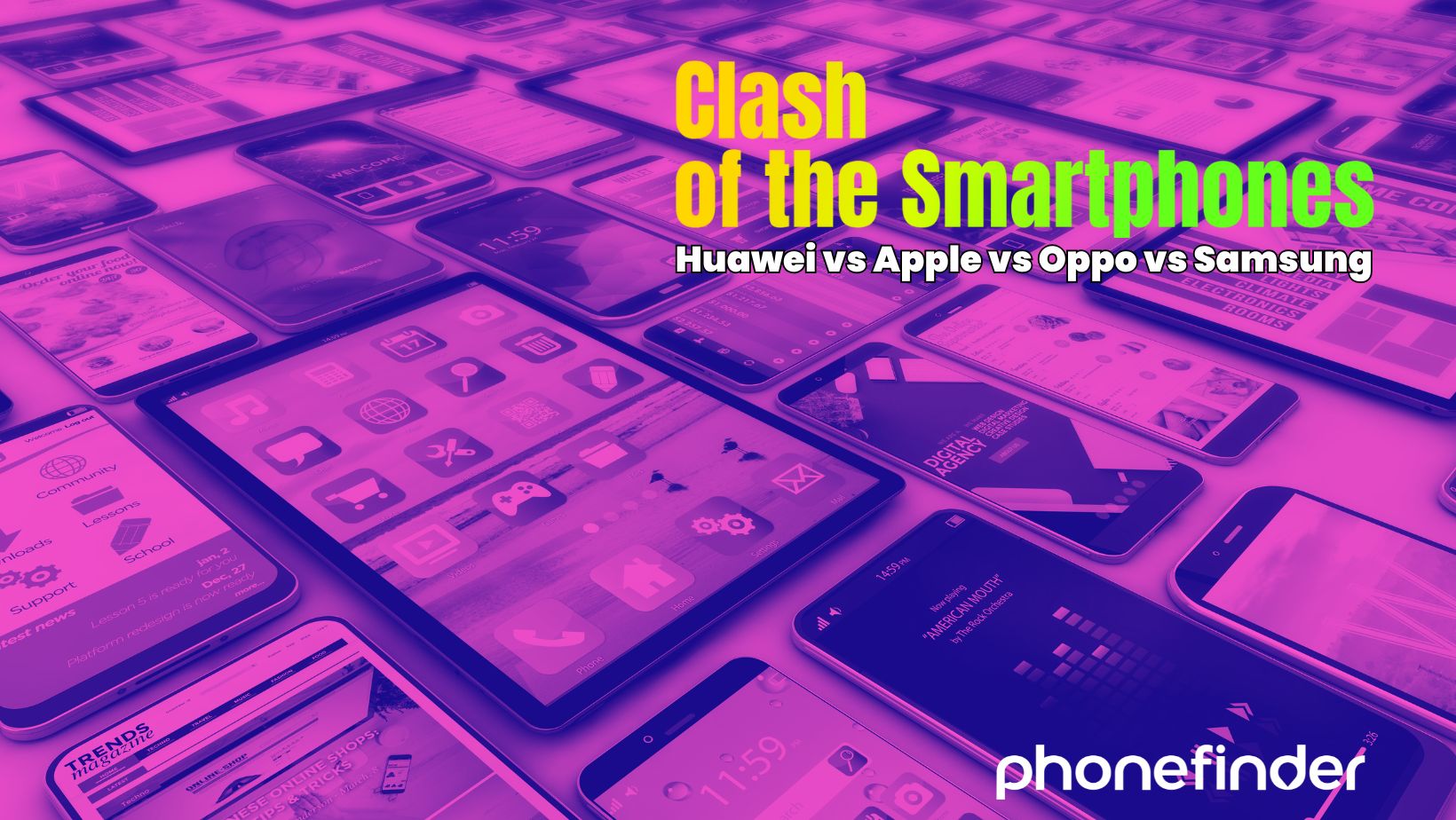Huawei vs Apple vs Oppo vs Samsung: The Ultimate 2025 Smartphone Comparison Guide
Huawei vs Apple vs Oppo vs Samsung – Compare features, performance, and pricing in this expert 2025 smartphone guide. Discover which brand truly leads.

Introduction to the Smartphone Giants
In 2025, choosing a smartphone is more challenging than ever. With Huawei, Apple, Oppo, and Samsung leading the global market, each brand offers cutting-edge technology, sleek designs, and unique ecosystems. Whether you’re a tech enthusiast or a casual user, this comprehensive comparison will help you make the best decision for your needs.
Brand Background and Market Presence
Huawei – Innovation and Global Strategy
Huawei continues to innovate despite geopolitical hurdles. Known for its powerful Kirin chipsets, advanced camera systems, and sleek designs, the brand has gained popularity across Europe, Asia, and parts of the Middle East. Huawei’s focus on AI and 5G makes it a leader in future-ready devices.
Apple – Ecosystem Excellence and User Trust
Apple’s ecosystem is unmatched. From iPhones to iPads, Macs, and services like iCloud, everything works in harmony. In 2025, the iPhone 16 series continues Apple’s tradition of security, sleek aesthetics, and industry-leading software updates.
Oppo – Value-Packed Technology for All
Oppo has cemented its place as a value-driven innovator. With powerful cameras, fast charging, and beautiful designs, the Find X8 Pro and Reno series offer flagship features at competitive prices. Oppo is strong in Asia and expanding in Europe.
Samsung – Display King with Broad Appeal
Samsung remains the global smartphone leader in volume. With premium models like the Galaxy S25 Ultra and innovative foldables, Samsung combines top-tier displays, long battery life, and a vast product range across all price segments.
Design and Build Quality Compared
Materials and Aesthetics
- Apple and Samsung offer premium glass-metal designs with refined edges.
- Huawei opts for elegant curves and ceramic back options.
- Oppo incorporates vegan leather backs and bold colours, appealing to younger users.
Durability and IP Ratings
- Samsung S25 Ultra and iPhone 16 Pro Max come with IP68 water resistance.
- Huawei Mate 70 Pro and Oppo Find X8 Pro also boast solid water and dust protection, though not always across the entire line-up.
Display Quality and Innovations
Screen Size and Resolution
- Samsung leads with Dynamic AMOLED 2X panels and 2K resolution.
- Apple’s Super Retina XDR remains bright and colour-accurate.
- Huawei and Oppo are close behind, offering 120Hz OLEDs with punchy colours.
Refresh Rate and Display Tech
- All four brands now support 120Hz refresh rates.
- Samsung and Huawei add LTPO tech for adaptive refresh rates, saving battery.
- Oppo’s curved edge displays remain user favourites for design.
Performance and Hardware Specs
Processors: Kirin vs A18 vs Snapdragon vs Dimensity or Exynos
- Apple A18 Pro leads in single-core and efficiency.
- Snapdragon 8 Gen 4 (Samsung, Oppo) offers excellent multi-core and GPU power.
- Huawei’s Kirin 9020 has improved post-5G sanctions and uses AI-driven performance.
- Exynos chips still appear in some Samsung models.
RAM and Storage Options
- Apple sticks with 8GB RAM but uses efficient memory handling.
- Others offer up to 16GB RAM and 1TB storage (UFS 4.0), ideal for power users.
Camera Capabilities and Image Quality
Rear Cameras
- Huawei Mate 70 Pro: 50MP variable aperture lens and periscope zoom.
- iPhone 16 Pro Max: 48MP sensor with Photonic Engine and LiDAR.
- Oppo Find X8 Pro: 50MP triple-camera with MariSilicon X chip.
- Samsung S25 Ultra: 200MP main sensor with Nightography.
Front Cameras
- Apple and Samsung focus on natural selfies.
- Huawei and Oppo offer more beautification filters.
Battery Life and Charging Speed
- Samsung and Huawei pack 5000mAh and larger batteries.
- Oppo offers excellent balance and extremely fast charging.
- Apple relies on efficiency rather than raw capacity.
Connectivity and Security
- All support 5G, Wi‑Fi 6E or 7, Bluetooth 5.3, NFC, and eSIM (varies by region).
- Apple: Face ID only.
- Samsung: Ultrasonic fingerprint and face unlock.
- Huawei and Oppo: Optical in-screen fingerprint and 3D face unlock.
Flagship Smartphone Comparison (2025)
| Brand | Display | Build and IP | Chipset | RAM / Storage | Rear Cameras | Front Camera | eSIM? | Battery and Life | Star Rating |
|---|---|---|---|---|---|---|---|---|---|
| Huawei | ~6.9″ OLED, ≈2832×1316, 120Hz | Ceramic or glass, IP68-ish | Kirin 9020 | 12–16GB / 256GB | 50MP variable aperture and 12MP periscope and 40MP ultrawide | ~13MP | Yes | 5500mAh, 100W wired, 80W wireless; solid life | 4.3 |
| Apple | 6.9″ Super Retina XDR OLED, 120Hz ProMotion | Glass and metal, IP68 | A18 Pro | 8GB / up to 1TB | 48MP wide and zoom and LiDAR | ~12MP | Yes | ~33h video; ~4350mAh; 27W wired, 15W MagSafe | 4.7 |
| Oppo | ~6.8″ AMOLED, ≈2780×1264, 120Hz | Glass and metal, IP68-ish | Dimensity 9400 | 12GB / 512GB | 50MP main and periscope and ultrawide | ~32MP | Yes | ~31h video; 5910mAh; 80W wired, 50W wireless | 4.4 |
| Samsung | 6.9″ Dynamic LTPO AMOLED 2X, 3120×1440, 120Hz | Glass and metal, IP68 | Snapdragon 8 Elite | up to 16GB / 1TB | 200MP wide and 50MP periscope and 10MP tele and 50MP ultrawide | ~12MP | Yes | ~31h video; 5100mAh; 45W wired; Qi2 wireless | 4.5 |
Mid-Range Smartphone Comparison (2025)
| Brand | Device and Display | Build and IP | Chipset | RAM / Storage | Rear Cameras | Front Camera | eSIM? | Battery and Life | Star Rating |
|---|---|---|---|---|---|---|---|---|---|
| Huawei | Pura 80: 6.6″ OLED FHD+, 120Hz | Glass and metal? | Kirin mid SoC | 12GB / 256GB | 50MP and 13MP ultrawide and 12MP periscope | Unknown | Yes | Good endurance and fast charge | 4.2 |
| Apple | iPhone SE 4 (16E): 6.1″ OLED, ~60Hz | Glass and aluminium, IP68 | A18 (rumoured) | 6–8GB / 128–256GB | Likely single 48MP | 12MP | Yes | ~3279mAh, efficient usage | 4.3 |
| Oppo | Reno 12 Pro: ~6.7″ AMOLED, 120Hz | Glass and metal | Dimensity 7300 Energy | 12GB / 512GB | 50MP triple including tele and ultrawide | ~32MP | Yes | ~5000mAh, strong value | 4.3 |
| Samsung | Galaxy A56 5G: 6.7″ Super AMOLED, 120Hz | Glass and metal, IP67 | Exynos 1580 | 8–12GB / 128–256GB | 50MP wide and 12MP ultrawide and 5MP macro | 12MP | Yes | 5000mAh, 45W, reliable life | 4.4 |
Budget Smartphone Comparison (2025)
| Brand | Device and Display | Build and IP | Chipset | RAM / Storage | Rear Cameras | Front Camera | eSIM? | Battery and Life | Star Rating |
|---|---|---|---|---|---|---|---|---|---|
| Huawei | Nova Y92-ish: ~6.5″ screen | Plastic | Mid-tier Kirin or MediaTek | 6–8GB / 128GB | ~50MP and basics | ~8–13MP | No | ~5000mAh | 3.8 |
| Apple | iPhone SE 3: 4.7″ LCD, IP67 | Glass and aluminium | A15 Bionic | 4GB / 64–256GB | 12MP single | 7MP? | No | Typical day’s use | 4.0 |
| Oppo | A3 5G: 6.67″ LCD, 120Hz | Plastic | Dimensity 6300 | 4–6GB / 128GB | 50MP and 2MP | 5MP | No | 5100mAh, 45W charge | 4.0 |
| Samsung | Galaxy A25 5G: 6.5″ Super AMOLED, 120Hz | Plastic and glass, IP67 | Exynos 1280 | 4–8GB / 128–256GB | 50MP and ultrawide and macro | 13MP | Yes? | 5000mAh, 25W charge | 4.0 |
About Phonefinder
Phonefinder is South Africa’s leading mobile contract comparison platform, helping you quickly and easily find the best smartphone deals from top networks like MTN and Cell C, as well as other major providers. Whether you’re after the latest flagship or an affordable budget device, Phonefinder brings all the options into one place so you can compare plans, prices, and benefits side by side. Our goal is to save you time, money, and hassle when upgrading your phone — all while ensuring you get a deal perfectly suited to your needs.


